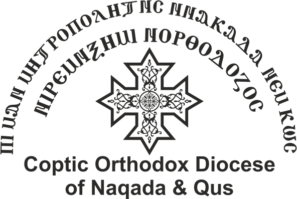The Holy Cross and Anba Shenouda Monastery
Location:
The monastery is located on the west bank of the Nile in the area of Hager Danfiq 6 km south of Naqada, facing Qerqtan village on the main road between Naqada and Qamula (part of the main road from Qena to Luxor) and 4 km south of Archangel Michael monastery. In the mid-seventies, the monastery was surrounded on all sides by the desert but now is encircled by the houses of the Arabs at Hager Danfiq. The state has paved the road leading to it.
History:
The monastery was built in the 4th century at the expense of Queen Helena, mother of King Constantine, after discovering the Holy Cross. It is the only monastery in the name of the Holy Cross in Egypt. Hundreds of monks populated its expansive buildings until the Islamic conquest of Egypt (641 AD).
What the historians said about the monasteries:
The Monastery was first mentioned in the biography of St. Basentaous (548-631 AD), who dwelt in it and ordained St. Andras as an abbot. However, the use of pharaonic stones, columns and the basilic construction style indicates that the monastery might have existed from the second half of the fourth century or the first half of the fifth century.
In the thirteenth century, it was referred to by the historian Abu Salih al-Armani, and in 1668 it was mentioned by the Capuchin Fathers and the French European travelers. Menarodes, Vancelip, Abi Al-Makarem, and Father Abdel-Masih Al-Masoudi.
Clark, a Coptic archaeologist, pointed out that the old monastery was destroyed in 1917 and was reconstructed. The only remaining part of the old church was its damaged sanctuary and some columns. Architectural studies indicate that the church of The Cross was in the form of a basilica, and in the 12th or 13th century, its wooden gabled roof collapsed. In the Mamluk era, the side rooms of the sanctuary were converted into altars.
The monastery has the following:
- Anba Shenouda Church:
This highly regarded church has only one altar in the name of the great saint Anba Shenouda. It is located in the western part of the monastery. The church underwent restoration, and a new baptistery was built during the reign of H.G. Bishop Biemen and under the supervision of the Antiquities Authority in 2002. It was inaugurated by H.G. Bishop Biemen and H.G. Bishop Youannis, Bishop of Assiut.
- St. Mary Church:
It is adjacent to the Holy Cross church and has two altars: the first in the name of St. Mary and the second in the name of St. Tawadros al-Mashreqi. There is also an altar that bears the icon of Queen Helena, who built this church.
- The Holy Cross church:
Built in the Basilica style, this church is rectangular in shape (18 meters X 11 meters) and its nave consists of three sections according to the ancient tradition of the ritual Coptic pattern. The first section is for believers, the second for penitents, and the third for catechumens before baptism. The old church was full of Coptic motifs and icons, and the inscriptions on its columns indicate that these columns were taken from the Pharaonic temples. The church has 15 low domes and four altars:
The front middle altar is in the name of the cross.
The middle altar at the back is also in the name of the cross.
The southern altar is in the name of St. John the Baptist.
The northern altar is in the name of Archangel Michael.
This church is characterized by the presence of two altars in the middle sanctuary because oil was miraculously exuding from the original alter in the middle sanctuary and therefore a second alter was added.
On the left side of the church, there is an archaeological basin that was used in Epiphany and was discovered during restoration. The bottom of the basin has the form of a Coptic cross.














